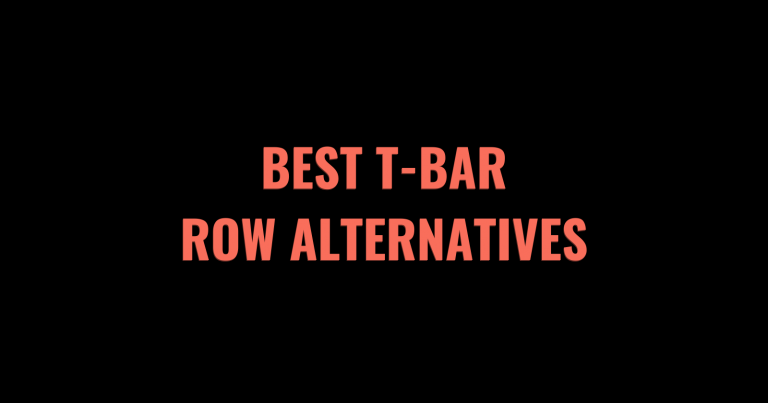The dumbbell pullover helps build and strengthen the lats, chest, and triceps while improving shoulder mobility.
However, if you’re in search of dumbbell pullover alternatives due to a physical limitation, equipment limitation, boredom, or any other reason, then you’ve come to the right place!
In this article, we’re going to cover the best exercise alternatives to the dumbbell pullover. Since the dumbbell pullover equally targets the lats and chest, we are going to provide some exercise alternatives for each muscle group.
Table of Contents
- 1 The 10 Best Dumbbell Pullover Alternatives
- 2 Lat Exercise Alternatives
- 3 Chest Exercise Alternatives
- 4 Reasons to choose a Dumbbell Pullover Alternative
- 5 Muscles Worked by the Dumbbell Pullover
- 6 Frequently Asked Questions
- 7 Final Thoughts
- 8 Other Alternative Exercises
- 8.1 The 10 Best Bent Over Row Alternatives
- 8.2 The 10 Best Overhead Press Alternatives
- 8.3 The 10 Best Front Squat Alternatives
- 8.4 The 9 Best Leg Press Alternatives
- 8.5 The 10 Best Pallof Press Alternatives
- 8.6 The 10 Best Glute Bridge Alternatives
- 8.7 The 12 Best Pull-Up Alternatives
- 8.8 The 8 Best Tricep Dip Alternatives
- 8.9 The 9 Best Seated Cable Row Alternatives (2023)
- 8.10 The 10 Best Lying Leg Curl Alternatives
- 8.11 The 10 Best Plank Alternatives
- 8.12 The 10 Best Leg Extension Alternatives
- 8.13 The 9 Best T-Bar Row Alternatives
- 8.14 The 10 Best Bulgarian Split Squat Alternatives
- 8.15 The 8 Best Hammer Curl Alternatives
The 10 Best Dumbbell Pullover Alternatives
- Cable Rope Pullovers
- Lat Pulldowns
- Straight-Arm Lat Pulldowns
- Single-Arm Lat Pulldowns
- Pull-Ups
- Barbell Bench Press
- Chest Fly
- Dumbbell Bench Press
- Push-Ups
- Floor Press
Lat Exercise Alternatives
Depending on how you perform the exercise, the dumbbell pullover can be classified as a lat or chest exercise. Since both muscle groups are engaged, we are going to cover 5 exercise alternatives that focus on the lats and 5 exercise alternatives that focus on the chest!
Cable Rope Pullovers
When to perform cable rope pullovers
If you’re looking for an exercise that’s nearly identical to the dumbbell pullover, a cable rope pullover is the best option because the movement pattern is exactly the same. Unlike free weights, such as dumbbells, cables place constant tension on the muscles.
This novel stimulus sparks new muscle growth, especially if you’ve hit a plateau with the dumbbell pullover. Not to mention, cable rope pullovers are easier to perform, safer to train to failure, and don’t require a bench or spotter.
Compared to the dumbbell pullover, cable rope pullovers target the lats to a greater extent than the chest so they are typically performed during back, pull, or upper body workouts.
How to perform cable rope pullovers
- Adjust a cable pulley to the highest position, attach a rope to it, and select an appropriate amount of weight.
- Stand facing the cable with a shoulder-width stance.
- Extend your arms and grab the end of the rope with a neutral grip.
- Take 2-3 steps back until there is tension in the cable.
- Brace your core and lean forward slightly while pushing your hips back. Your arms should be extended in front of you with your upper arms next to your ears. This is the starting position.
- Begin the movement by taking a deep breath, then focus on driving your elbows down and back while keeping a slight bend in your arms.
- As your hands approach your upper thighs, retract your shoulder blades, pause for 1-2 seconds, and slowly return to the starting position.
- Repeat for the desired number of repetitions.
Check out the video below from the Muscle Mentors to see how to perform the cable rope pullover correctly!
Cable rope pullover tips
- For optimal results, use a long rope attachment. But if your gym doesn’t have a long rope attachment, you can use two ropes, straighten each one, and use them as two individual ropes.
- This exercise trains the lats in a shortened range, so it’s best to perform it early in the workout since it gets more difficult to shorten the lats as they become fatigued.
- Standing closer to the cable stack will make it easier for you to target your lats. In other words, you will most be stronger which will allow you to lift more weight through a full range of motion.
Lat Pulldowns
When to perform lat pulldowns
One of the primary muscle groups that are activated during the dumbbell pullover is the lats. If you would like to directly target the lats and minimize chest engagement, or you don’t have access to dumbbells, the lat pulldown is a better option. Lat pulldowns are arguably safer to perform since it’s easier to get into the proper position.
Since you don’t need a spotter, you can safely train to failure, which is ideal if hypertrophy is your primary goal. Like cable rope pullovers, most lat pulldown machines utilize a cable, which places constant tension on the lats. Additionally, lat pulldowns help improve scapular positioning and control, which may enhance shoulder mobility and posture.
The lat pulldown is classified as a back exercise, so they are best performed during back, pull, or upper body workouts.
How to perform lat pulldowns
- Attach a standard lat pulldown bar to the cable pulley and select an appropriate amount of weight. Adjust the height of the seat and/or the support pads to where your legs are secured when seated.
- Facing the cable or lat pulldown machine, grab the bar with a slightly wider than shoulder-width pronated grip.
- Sit down on the seat and secure your knees under the support pads.
- Before starting the movement, take a deep breath, brace your core, and engage your scapula (shoulder blades), by driving down and slightly back.
- Pull the bar to your chest by further retracting and depressing your shoulder blades, adducting your upper arms, leaning back slightly, and flexing at the elbow.
- Once the bar touches your mid-upper chest, pause for 1-2 seconds before slowly returning the bar back to the starting position.
- Repeat for the desired number of repetitions.
Watch the video below from Mind Pump to see how to target your lat effectively with the lat pulldown!
Lat pulldown tips
- For the best lat engagement, align your chest directly with the bar, if you lean too far back, you’re going to recruit more of the lower trap and less of the lat.
- As the bar approaches your chest, focus on bringing your chest to the bar by lifting it slightly up. The bar should touch the top or middle of your chest between every rep.
- Visualize pulling your scapula (shoulder blades) downward as opposed to just backward.
- Adjust the grip width to see where you feel the movement most in your lats.
High Machine Rows
When to perform high machine rows
High machine rows are a great exercise for targeting the lats, as well as other back muscles, such as the traps, rhomboids, and posterior delts. Most gyms have a seated high row. If the dumbbell area is too busy, you don’t feel comfortable doing dumbbell pullovers, or you want to target the lats more, this is a great substitution.
Depending on the machine, it may use plates or cables, but either way, you can safely train to failure without a spotter. Since there is less core and lower back involvement, machine high rows help minimize fatigue.
Lastly, since your upper body is supported, you’re less likely to cheat the movement by using momentum, so you can place a greater emphasis on the lats. This movement may be easier for beginners to learn since it’s machine-based.
Machine high rows are considered to be a back exercise, so performing them during back, pull, or upper body workouts is ideal.
How to perform high machine rows
- Adjust the height of the seat to where the top of the support pad lines up with the top of your chest. Load an appropriate amount of plates on the machine or select an appropriate amount of weight if using a cable pulley system.
- Sit down and secure your knees or upper thighs under the support pads. Plant your feet on the ground. Keep your chest supported against the pad throughout the entire movement.
- Reach up and grab onto the handles using a pronated grip.
- Take a deep breath, then exhale while pulling the handles down and back by retracting your scapula, slightly adducting your upper arms, and flexing at the elbows.
- Once you’ve reached peak contraction and you can’t move the handles any farther back, pause for 1-2 seconds before slowly returning the handles back to the starting position.
- Repeat for the desired number of repetitions.
Watch the video below to see how to perform seated high machine rows properly!
High machine row tips
- Keep your chest on the pad at all times.
- You can perform this movement one arm at a time if you have a strength or muscular imbalance.
- Focus on driving your elbows down and back while retracting your scapulas.
Single-Arm Lat Pulldowns
When to perform single-arm lat pulldowns
The single-arm lat pulldown is one of the best ways to isolate your lats because it involves direct shoulder extension, which is a primary movement of the lat. If you have a muscular imbalance, doing unilateral exercises, such as the single-arm lat pulldown is crucial.
Training one arm at a time helps reduce muscular imbalances, thereby decreasing your risk of injury. If you notice that one lat is stronger or more developed than the other, we highly recommend doing single-arm lat pulldowns as opposed to dumbbell pullovers.
Single-arm lat pulldowns are a safer exercise, use a cable for constant tension, and do a better job at isolating the lat. It’s a good idea to start with your weaker side first, then match the number of reps you get with the stronger side. Over time, this will help even out both sides so you have a more symmetrical and balanced physique.
It’s important to note that even if you don’t have access to a lat pulldown machine, you can still perform this movement using a standard cable pulley by kneeling on the ground. Since the single-arm lat pulldown is strictly a back exercise, perform them during back, pull, or upper body workouts.
How to perform single-arm lat pulldowns
- Adjust a cable pulley to the highest position, attach a D-handle to it, and select an appropriate amount of weight.
- Facing the cable, grab the handle with your right arm using a neutral grip.
- Place your right knee on the ground with your left foot forward in a half-kneeling stance. Your arm should be fully extended and slightly in front of your body.
- Before starting the movement, take a deep breath and brace your core.
- Drive your elbow straight down by contracting your lat and flexing at the elbow.
- Once you feel a strong contraction in the lat, pause for 1-2 seconds, and slowly return the cable back to the starting position.
- Repeat for the desired number of repetitions. Do the same thing on the opposite side.
To see how to perform the single-arm lat pulldown with a standard cable pulley, watch the video below!
Single-arm lat pulldown tips
- Start with your weaker side and match the number of repetitions you get with the stronger side.
- If you’re performing the exercise with your right hand, place your right knee on the ground with your left leg forward and vice versa.
- If you have access to a lat pulldown, you can also perform this exercise in a seated position with the lat pulldown.
- Depending on the gym floor, you may need to place a mat under your knee.
Pull-Ups
When to perform pull-ups
If your access to equipment is limited but you want to target the lats effectively, nothing beats a traditional pull-up. Whether you have access to an entire gym or just a pull-up bar at the park, pull-ups are one of the most effective ways to build and strengthen your back and biceps.
If you’re a more advanced trainee, you can add weight by using a belt or weight vest. On the other hand, if you struggle with pull-ups, grab some resistance bands for assistance or use an assisted pull-up machine.
Compared to the dumbbell pullover, pull-ups are a more functional movement, so if you’re an athlete, they are a more suitable option. Unlike the dumbbell pullover, you don’t need any equipment to do pull-ups! Pull-ups are also considered to be a back exercise and should be performed during back, pull, or upper body workouts.
How to perform pull-ups
- To do this exercise, you can use an assisted pull-up machine or standard pull-up bar. If you don’t have access to either, look for something that’s high enough and sturdy enough to grab onto.
- Stand facing the pull-up bar with a shoulder-width stance. Grab onto the pull-up bar with a slightly wider than shoulder-width pronated grip.
- Bend your knees and cross your legs behind you so there’s clearance with the floor.
- Begin the movement by inhaling and bracing your core, then pull your chin up to the bar by flexing at the elbows, adducting your shoulders, and retracting your shoulder blades.
- As your chin reaches the bar, lean back slightly to better engage your lats.
- At the top of the rep, pause for 1-2 seconds before slowly lowering yourself back to the starting position.
Pull-up tips
- If your grip is a limiting factor, consider using chalk or lifting straps.
- Using a wider grip may engage your lats more.
- Always use a full range of motion, which means a full stretch at the bottom and your chin reaches over the bar at the top.
- If you want to improve your pull-up performance, consider doing them more frequently.
Chest Exercise Alternatives
Other than the lats, the chest is a primary muscle group that’s targeted during the dumbbell pullover. Not to mention, the more you pull the dumbbell over your chest, the more the chest is involved.
However, if you’re trying to increase the size and strength of your chest, there are several other exercises that are more effective, such as the bench press, chest flys, dumbbell bench press, and even push-ups!
Bench Press
When to perform the bench press
The bench press is a compound movement that builds and strengthens the chest, triceps, and anterior delts. Compared to the dumbbell pullover, the bench press activates the chest to a greater extent and you can move more weight, which is better for progressive overload.
It’s also a more functional exercise than the dumbbell pullover, which is why it’s used in several strength sports, such as powerlifting, strongman, and CrossFit. By changing the angle of the bench, you can target the upper, middle, or lower chest more or less.
The bench press is a superior exercise to the dumbell pullover if your goal is to increase the size and strength of your upper body, especially the chest. Since the bench press is primarily considered to be a chest exercise, you should perform it during chest, push, or upper body workouts.
How to perform the bench press
- Adjust the height of the rack to where you can easily un-rack and re-rack the barbell with a slight bend in your elbows.
- Place the barbell on the rack and load an appropriate amount of weight.
- Lay down on the bench and place your feet firmly on the ground. The barbell should be directly above your eyes.
- Grab the barbell with a shoulder-width pronated grip.
- Retract and depress your shoulder blades by engaging your lats. There will be a slight arch in your lower back, but your butt should remain in contact with the bench throughout the entire movement.
- Unrack the barbell by fully extending your arms to lift the barbell up. Move your arms forward until the barbell is directly about the top of your chest.
- Take a deep breath, then lower the barbell down to the middle of your chest. Keep your elbows slightly tucked (between 60-70 degrees).
- Once the barbell touches your chest, pause for 1-2 seconds, and exhale while you push the barbell up and slightly backward to the starting position.
- Repeat for the desired number of repetitions.
Check out the video below from Jeff Nippard to see how to correctly execute the bench press:
Bench press tips
- If you want to keep your chest engaged throughout the entire movement, don’t completely lockout at the top of each rep.
- The bar path should have a slight arch/curve, it shouldn’t move straight up and down.
- Manipulate your grip width to target or chest or triceps more or less.
- Practice using hip drive to lift more weight over time.
- If you’re a strength athlete, incorporate pauses to get used to competition standards.
Chest Fly
When to perform the chest fly
The chest fly is one of the only ways to isolate your pectoral muscles. It can be performed with cables, machines, resistance bands, and dumbbells. The chest fly is a better exercise for building the chest compared to the dumbbell pullover because it directly targets the chest via horizontal adduction of the shoulder.
To target the upper, lower, or middle chest, you can switch up the angle of the bench or the height of the cables. Using cables or machines as opposed to free weights may be optimal because the muscle is placed under constant tension.
Since the chest fly is an isolation exercise, you can increase volume without taxing other muscle groups. Perform chest flys during chest, upper body, or push workouts.
How to perform the chest fly
- Position a dual cable pulley to chest height, attach a D-handle to each side, and select an appropriate amount of weight.
- Stand in the middle of the cables and grab each handle with your palms facing out.
- Take 2-3 steps forward and assume a split stance (one foot forward, one foot back).
- Keep a slight bend in your elbows throughout the exercise. Lean slightly forward, arch your chest and retract your shoulders. You will feel a stretch in your chest at the start of the movement.
- Inhale as you bring the cables together by moving your arms horizontally.
- Once your hands are together, pause for 1-2 seconds, and focus on squeezing your chest.
- Exhale as you return the cables to the starting position.
- Repeat for the desired number of repetitions.
In the video below, Scott Herman demonstrates how to perform the standing cable chest fly!
Chest fly tips
- Using a bench or pec-dec machine can help eliminate cheating by reducing momentum.
- Keep your shoulders retracted throughout the movement to prevent anterior delt involvement.
- Maintain a slight bend in your elbows at all times and focus on bringing your upper arms together as opposed to your hands.
- Manipulate the angle of the cables to emphasize a certain area of the chest. For example, an low to high cable fly will target the upper chest, whereas a high to low cable fly will target more of the lower chest.
- If you struggle to feel your chest working during presses, do chest flys first to pre-exhaust the chest and improve your mind-muscle connection.
Dumbbell Bench Press
When to perform the dumbbell bench press
The dumbbell bench press is a more effective way to target the chest, triceps, and anterior delts than the dumbbell pullover. Like the bench press, you can lift more weight compared to a dumbbell pullover, which leads to a greater opportunity for progressive overload.
Another advantage to the dumbbell bench press is that it’s a unilateral exercise, so each arm moves independently. As we mentioned before, unilateral exercises are ideal for correcting and preventing muscular imbalances. If you have access to an adjustable bench, you can change the angle to target a specific area of the chest.
The dumbbell bench press is usually performed during chest, upper body, or push workouts because it directly engages the chest, triceps, and front delts.
How to perform the dumbbell bench press
- To do this exercise, you will need a pair of dumbbells and a flat or adjustable bench.
- Grab the dumbbells with a neutral grip and sit down on the bench. Place the dumbbells on the top of your upper legs.
- While keeping the dumbbells close to your chest, lean back and push the dumbbells up until your arms are fully extended. Rotate the dumbbells until your hands are in a pronated position.
- Plant your feet on the floor, retract your shoulder blades, and create a slight arch in your lower back. Keep your butt planted on the bench at all times.
- Take a deep breath and lower the dumbbells to your chest by flexing your elbow and horizontally abducting your arm. Keep your elbows tucked to a 60-70 degree angle.
- Once the dumbbells touch your chest, pause for 1-2 seconds.
- Exhale as you push the dumbbells up by extending your elbow and horizontally adducting your upper arm until your arms are almost completely locked out.
- Repeat for the desired number of repetitions.
In the video below, Athlean-X demonstrates how to get the most chest activation during the dumbbell bench press!
Dumbbell bench press tips
- Adjust the angle of the bench to target different areas of the chest. An incline will target the upper chest, flat targets the middle chest, and decline targets the lower chest.
- Use a spotter if you’re training to failure.
- Keep your shoulders retracted to limit anterior delt involvement.
- Avoid completely locking out your elbows at the top of each rep to keep tension on the chest.
Push-Ups
When to perform push-ups
Similar to pull-ups, push-ups are a bodyweight exercise that can be performed anywhere. They target the chest, triceps, and anterior delts more effectively than a dumbbell pullover, and you don’t need any equipment! You can quickly adjust your hands to emphasize the chest or triceps more or less.
Not to mention, push-ups are very scalable. You can add weight to make them more difficult, or you can go on your knees if standard push-ups are too challenging. Compared to the dumbbell pullover, push-ups are more functional and have better carry over to other exercises, such as the bench press.
How to perform push-ups
- Get on all fours and place your hands slightly outside shoulder-width apart at chest level.
- Extend your legs back and place them hip-width apart with your toes facing forward.
- Tighten your core and squeeze your glutes so that your spine is in a neutral position.
- Look straight ahead and keep your ears in line with your shoulders.
- Take a deep breath then begin to lower your body to the floor by bending your elbows. Keep a 60-70 degree tuck in your elbows. Your upper and lower body should move at the same time and pace.
- Once your chest is 1-2 inches away from the floor, pause for 1-2 seconds.
- Exhale as you push yourself up and away from the floor by contracting the chest and triceps.
- At the top of the rep, lock out your elbows and pause for 1-2 seconds. Repeat for the desired number of repetitions.
Watch the video below to see how to perform the perfect push-up!
Push-up tips
- Keep your core tight and maintain a neutral spine by squeezing your abs and glutes.
- To make push-ups more challenging, add weight by placing a plate on your back or using a weighted vest, slow down the reps, place your feet on an elevated surface, or use parallel bars.
- To make push-ups easier, try doing a modified variation by placing your knees on a mat or using an elevated surface (ex. wall push-ups).
- If you want to target the triceps more, use a close grip; if you want to target the chest more, use a wider grip.
Machine Chest Press
When to perform the machine chest press
The last exercise we are going to highlight is the machine chest press. Just like all of the other chest exercises we mentioned, the machine chest press is far superior to the dumbbell pullover for building your chest.
Compared to the other chest exercises on this list, it’s easier and safer to learn for beginners because it’s not as technical and fewer stabilizer muscles are involved. And it’s also safer if you’re training to failure because you don’t need a spotter and are in a fixed position so there’s less of a chance of injury.
A machine chest press is usually performed during upper body, chest, or push workouts.
How to perform the machine chest press
- Adjust the seat height to where the handles are at chest level. If it’s a pin-loaded machine, select an appropriate amount of weight. If it’s a plate-loaded machine, simply load as many plates as necessary.
- Sit down on the bench, plant your feet on the floor, and grab the handles with a shoulder-width pronated grip.
- Retract your shoulders, keep your chest up, and create a slight arch in your lower back
- Take a deep breath then exhale as you push the handles forward by extending your arms.
- At the top of the rep, squeeze your chest and hold for 1-2 seconds.
- Slowly lower the handles back to the starting position. Keep a 60-70 degree tuck in your elbows.
- Repeat for the desired number of repetitions.
Check out the video below from Scott Herman to see how to perform the machine chest press!
Machine chest press tips
- To keep tension on the chest, don’t lock your elbows out at the top of each rep.
- Keep your chest up, and shoulder retracted to limit anterior delt involvement.
- Focus on bringing your upper arms together as opposed to your hands.
Reasons to choose a Dumbbell Pullover Alternative
The dumbbell pullover is an old-school exercise that was extremely popular amongst early bodybuilders. Although the dumbbell pullover is an effective exercise, its high risk and low reward have caused it to fall out of favor. Instead of feeling the chest and lats working, most feel discomfort in their shoulders when performing the dumbbell pullover.
Not to mention, it’s difficult to get into the proper position, and training to failure is quite risky, especially if you don’t have a spotter. Fortunately, there are several safer exercise alternatives to the dumbbell pullover, such as the cable pullover. These exercises share similar movement patterns, but the cable is friendlier on your joints.
If you’re looking to develop your chest or lats, there are numerous exercises that better target those muscle groups. For the chest, perform chest flys, dumbbell bench presses, push-ups, or bench press. For the lats, try lat pulldowns, pull-ups, or even single-arm lat pulldowns.
In other words, if your program has the dumbbell pullover included but you don’t feel comfortable or confident doing the exercise, swapping it out is a wise choice. What’s more, if you’ve been doing the dumbbell pullover and hit a plateau, switch things up by picking an alternative exercise that still targets that muscle but keeps things fresh and fun!
Muscles Worked by the Dumbbell Pullover
The dumbbell pullover primarily targets the latissimus dorsi, also known as the lats, and pectoralis major, also known as the chest. Secondarily, the dumbbell pullover trains the triceps, abs, teres major, serratus anterior, posterior delt, and anterior delt.
Primary Muscles
- Lats
- Chest
Secondary Muscles
- Abs
- Teres major
- Serratus anterior
- Posterior delt
- Anterior delt
- Triceps
Frequently Asked Questions
Are dumbbell pullovers bad for your shoulders?
Any exercise performed incorrectly can place you at a higher risk of injury. With that said, the answer to this question will depend on the person. If you have a pre-existing shoulder injury or poor shoulder mobility, then performing traditional dumbbell pullovers isn’t ideal.
If you do a dumbbell pullover and feel pain in your joints, you should seek an alternative exercise. It’s also important to note that the movement pattern involved with the dumbbell pullover has a higher risk for shoulder dislocations because of the overhead position.
When should I perform dumbbell pullovers?
Programming the dumbbell pullover is quite tricky since it works the chest and back, which are normally considered to be antagonist muscle groups. In other words, the chest is responsible for pushing movements, whereas the back performs pulling movements. So it’s quite rare to have an exercise target both muscle groups.
The answer to this question also depends on your training split. If you train four times per week with an upper/lower split, program them on upper body days. However, if you do a “bro” split and only train one muscle group a day, that’s where it can become more difficult.
There isn’t a right or wrong answer to this question, but more often than not, the dumbbell pullover is programmed on back days.
Final Thoughts
Although it’s a good idea to generally follow the exercises that are written in your program, you can and should seek out alternatives if you have a physical limitation, equipment limitation, have plateaued with a specific exercise, or are looking to further isolate a certain muscle.
The dumbbell pullover is an effective exercise for building and strengthening the chest and lats. But it places you at a higher risk of injury, especially if you’ve had shoulder injuries in the past. There are plenty of alternative exercises that are superior for targeting the chest and lats.
If you can’t do dumbbell pullovers for any reason, try out some of the exercises we’ve highlighted above so you can keep making progress and reach your goals!
Other Alternative Exercises
If you enjoyed this post, check out our other roundups of the best alternatives for other exercises.
About Heather Jacques
Heather Jacques is a former collegiate athlete that graduated from Grand Valley State University with a Bachelor of Science in Athletic Training. Along with writing content for Lift Vault, Heather works for one of the fastest growing sports nutrition companies, Axe & Sledge Supplements, as their product specialist. Heather is an avid lifter, snowboarder, and outdoor enthusiast. She was born in Colorado, raised in northern Michigan, and currently resides in Pennsylvania. Heather's primary goal is to help others achieve their health and fitness goals through education, motivation, and inspiration.













